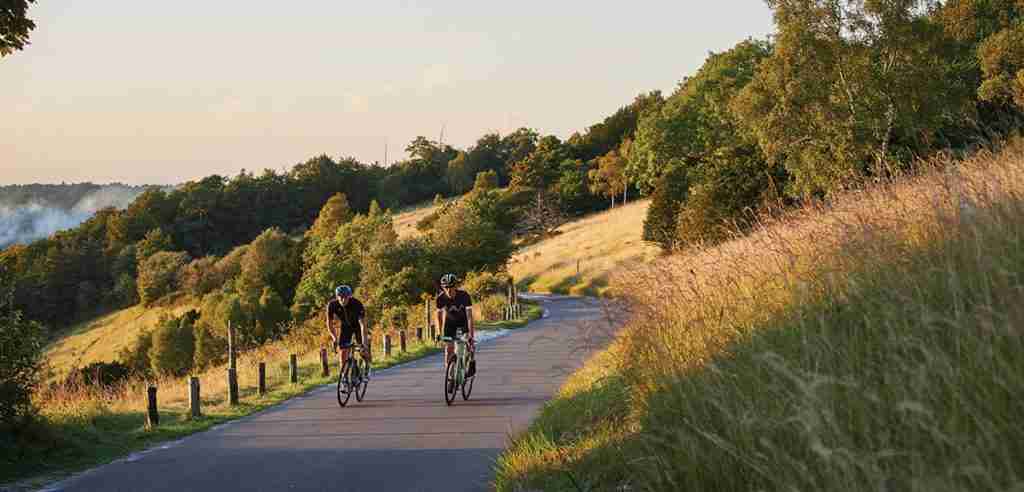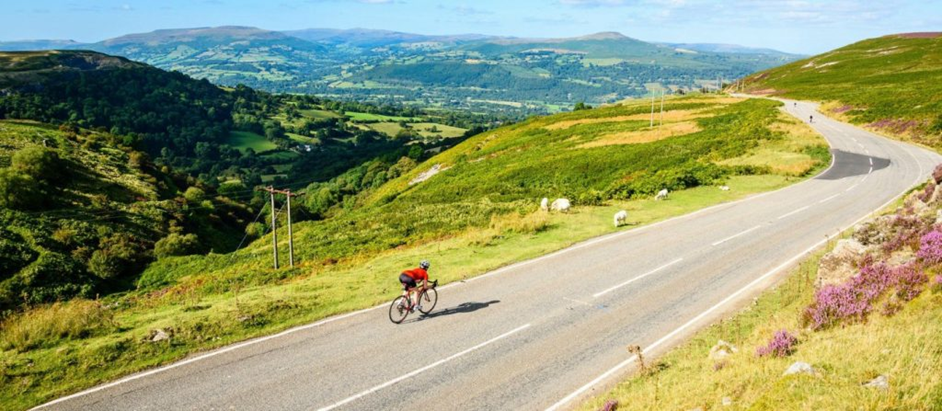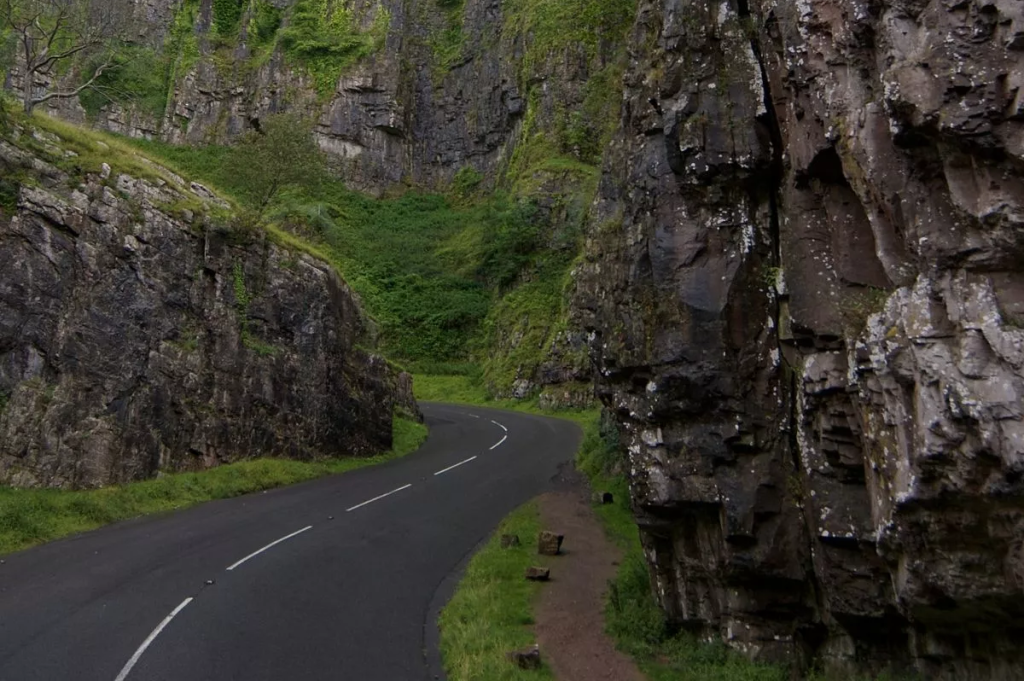
A Cycling Adventure
Discover seven of the top climbs for cyclists in the UK, from the daunting Hardknott Pass in Cumbria to the breathtaking Bealach-Na-Ba in the Scottish Highlands. Explore these exhilarating ascents, each with its own unique characteristics and difficulties, and experience the joy and struggle of conquering steep gradients and switchbacks. Whether you reside in the flatlands of Lincolnshire or Cambridgeshire, or you embrace the challenges of undulating terrain, at some point during your ride, you’ll encounter the need to shift gears and battle gravity. Climbing presents a unique set of demands, requiring not only physical fitness but also technique, stamina, and mental resilience. Above all else it creates a challenge!
At the heart of all the greatest challenges, you will find the person that inspired it all. Simon Warren has been obsessed with cycling since the summer of 1989 after watching Greg Lemond battle Laurent Fignon in the Tour de France. A few weeks later he rode his first race, a 10 mile time trial on the A1 from Newark to Grantham and back. Although not having what it took to beat the best, he found his forte was racing up hills, and so began his fascination with steep roads. His quest to discover Britain’s greatest climbs resulted in the bestselling 100 Greatest Cycling Climbs, followed by Another 100 Greatest Cycling Climbs, Hellingen: A Road Cyclist’s Guide to Belgium’s Greatest Cycling Climbs and 100 Greatest Cycling Climbs of the Tour de France: A Cyclist’s Guide to Riding the Mountains of the Tour.
Now thanks to Simon, we are all on a quest to complete the climbs. In this article, we’ll explore some of the most challenging climbs in the UK, each offering its own exhilarating experience. So, gear up, conquer those ascents, and make your rides truly memorable.
Hardknott Pass, Cumbria #84

Key Features
- Elevation: 292 meters
- Length: 2.2 kilometers
- Average Gradient: 13.0%
- Max Gradient: 33.0%
- Spectacular vistas of the Wrynose Pass and Scafell Pike, England’s highest mountain
- 10/10
KOM: 9.15
QOM: 13.35
Nestled within the breath taking Lake District National Park, Hardknott Pass stands as one of the UK’s most demanding climbs. With an average gradient of 13%, and sections reaching 30%, conquering this ascent requires both physical & mental strength. The serpentine road offers breath taking views of the surrounding peaks, rewarding those who brave its challenge. It connects the Duddon Valley in the West with the Eskdale Valley in the East and reaches an elevation of 393 metres (1,289 feet) above sea level.
Renowned as one of the UK’s most gruelling climbs, Hardknott Pass haunts even the most hardened riders. Once you cross the beautiful River Duddon, you’ll begin your journey through Hardknott Pass from East to West. Your journey will begin with 30% gradients that last a little over a mile.
This ascent also consists of a series of punishing switchbacks, with the eastern side hosting the toughest section featuring 25% corners. After a brief respite on flatter terrain, you’ll face the second set of switchbacks, where steep 30% gradients will push your body to its limits. If you plan to ride in this area, ensure your gear ratios are suitable, unless you want to find yourself pushing your bike.
For cyclists starting in the West, you’ll ascend to a gentle gradient (don’t be fooled!) while riding alongside the beautiful River Esk. Keep your eyes on the road up ahead, as you’ll soon come to the first 20% of the slopes that last for around 500 metres.
Things will ease up in the next kilometre, with an easy 8% gradient to tackle: this is where you should consider reducing your speed, giving yourself to recover a little before you’ll contend with the final section of 30% hairpin twists. They aren’t all this punishing, however. Some of these bends range between 15-30%, making this final 300-metre stretch more manageable.
Brace yourself for a brutal challenge that only Cumbria can deliver!
Box Hill, Surrey #14

Key Features
- Elevation: 132 meters
- Length: 2.4 kilometers
- Average Gradient: 5.0%
- Max Gradient: 8.0%
- Serene views of the Surrey Hills Area of Outstanding Natural Beauty
- 3/10
KOM: 4.20
QOM: 5.07
While Box Hill may not be the most daunting climb on our list, it holds a special place for cyclists in and around London, arguably the most famous of all the climbs in Surrey . With an average gradient of 5%, it offers a nostalgic allure as part of the iconic 2012 London Olympic Games route.
At 2.5 kilometers in length, it’s long enough to settle into a rhythm, and although the gradients aren’t as steep as some (maxing out at 8 per cent and averaging five), that only serves to allow you to truly enjoy the climb.
Box hill is also known as ‘Zig Zag’ hill, the road switches back three times on the way up, giving the climb a distinctly Alpine feel. The best bit about them is they ease off on the turns as well, which allows you to accelerate and slingshot out of each one as you chase your best time. It also offers great views of the surrounding countryside.
The hill’s ultra-smooth surface exudes European vibes, and once you reach the summit, you’ll be rewarded with a panoramic view of Surrey Hills and the South Downs and you can enjoy a coffee and cake as reward at the National Trust café. Just beware of the speed bumps on the descent and enjoy the ride at a safe pace.
The Tumble, Monmouthshire #97

Key Features
- Elevation: 362 meters
- Length: 4.5 kilometers
- Average Gradient: 8.0%
- Max Gradient: 16.0%
- 7/10
KOM: 11.34
QOM: 13.59
The Tumble definitely warrants a place in the top seven climbs of the UK. It is considered one of Wales’ most feared and beloved climbs, and literally on our doorstep here at Port Velo. The Tumble poses a significant test for any cyclist, serving as the Tour of Britain’s mountain top finish in 2014.
From Abergavenny, you head north-west up the Usk valley to the outskirts of Govilon, where the climb proper starts, the road gradually inclines, allowing you to find your rhythm and settle into the climb. The road lurches up steeply, over the Brecon and Monmouthshire canal and round a tight left-hand bend. The first landmark, after a long, painful straight is the ‘Fiddler’s elbow’. Round this and the gradient nudges into double figures, through a conifer plantation.
However, as you approach the halfway point, the gradient intensifies, demanding every ounce of strength from your legs. As you make a sharp left turn, the route becomes steeper, with the asphalt deteriorating along the way, as you start the proper climb to the summit.
In wet conditions navigating the cattle grid halfway up can be tricky. However, the reward for your efforts awaits—a captivating landscape overlooking the beautiful surrounding valleys of the Brecon Beacons National Park and back over your shoulder, north into the glacially sculpted hills and valleys of the Black Mountains. Conserve some energy as you ascend, especially as you near the top, there are a couple of short, steep, out of the saddle ramps before the final section – a luxury at 3-4% – past the tarn and on to the top.
Bealach-Na-Ba, Scottish Highlands #69
Bealach-Na-Ba by Simon Li
Key Features
- Elevation: 608 meters
- Length: 9.2 kilometers
- Average Gradient: 7.0%
- Max Gradient: 20.0%
- Stunning panoramic views of the Isle of Skye and surrounding mountains
- 11/10
KOM: 24.44
QOM: 31.05
Nestled within the stunning Applecross Peninsula in the Scottish Highlands, Bealach-Na-Ba promises an awe-inspiring and breath-taking experience. Rising 626 meters over a distance of 9.1 kilometers from sea level, this climb is tailored for the true enthusiasts. Be prepared for the savage 20% gradient that persists for 500 meters, challenging your every pedal stroke. As if the climb itself wasn’t daunting enough, the weather systems in the Scottish Highlands can unleash their apocalyptic fury. Brace yourself for an adventure like no other.
Mow Cop, Staffordshire #36
Katie Kookaburra riding ‘The Killer Mile’.
Key Features
- Elevation: 161 meters
- Length: 1.46 kilometers
- Average Gradient: 11.0%
- Max Gradient: 25.0%
- The imposing ruins of the Mow Cop Castle
- 9/10
KOM: 4.55
QOM: 6.29
Nestled in the scenic Cheshire countryside, Mow Cop presents a thrilling and challenging climb that has captured the imagination of cyclists far and wide. With its gruelling gradient and breath taking views, this ascent demands strength, endurance, and unwavering determination. At only 1.46 kilometers long, Mow Cop might seem deceptively manageable. However, its steepness has earned it the nickname “The Killer Mile” among those in the know.
The climb starts after a busy level crossing, initially, the gradient is a respectable 8-10%, but after a while you reach the first steep part – approaching 20%. The gradient then eases off in the middle section, but as you come around the corner, the final stretch of 25% looms menacingly on the horizon. The house to the left, which once was a pub, starkly highlights the gradient.
The final section of this climb is so steep that photographers often gather during sportives to capture riders struggling to maintain their balance. Take heed of the wisdom in pacing yourself, as starting too hard will leave you gasping for breath before reaching the most challenging part.
Cheddar Gorge, Somerset #1

A friend of Port Velo @pressuno riding his favourite climb ‘Cheddar Gorge’.
Key Features
- Elevation: 153 meters
- Length: 3.66 kilometers
- Average Gradient: 5.0%
- Max Gradient: 16.0%
- Fascinating geological formations and the stunning Cheddar Reservoir
- 3/10
KOM: 7.18
QOM: 8.46
Among the climbs on our list, Cheddar Gorge offers a more pleasant and visually stunning experience. Stretching approximately 4.6 kilometers through the picturesque Mendip Hills, this ascent rewards cyclists with a beautifully smooth road cutting through mighty rock faces. Unlike a formidable brick wall, the gradient profile allows you to appreciate the remarkable views. The climb’s toughest section is near the beginning, enabling you to gather momentum and relish the journey as you approach the summit.
Cheddar Gorge understandably features in many local sportives and is a popular destination for many cyclists. It is also popular with tourists and rock climbers. The road can be busy – especially as you leave the village of Cheddar. Cheddar Gorge forms part of the Mendips in Somerset. There are plenty of other good hills and roads around here and it is you will find us here at Port Velos most weekends. Because of the spectacular nature of Cheddar Gorge and the surrounding landscapes, we curated some of our routes into the ‘Three Counties Tour’ where we tackle the Gorge and other top climbs in the area.
Did you know that Cheddar Gorge is also home to the Cheddar Show Caves, where the ancient skeleton of Cheddar Man—estimated to be 9,000 years old—was discovered?
Buttertubs Pass, Yorkshire #49

Key Features
- Elevation: 214 meters
- Length: 3.86 kilometers
- Average Gradient: 9.0%
- Max Gradient: 25.0%
- Magnificent vistas of the Yorkshire Dales National Park
- 8/10
KOM: 9.20
QOM: 12.39
Prepare to be captivated by the mesmerizing beauty of the Yorkshire Dales as you conquer the Buttertubs Pass. This climb, named after the limestone potholes that line its route, offers a unique and challenging experience. The stunning panoramas of the dales and the sense of accomplishment make this climb an unmissable gem.
Featured in stage one of the 2014 Tour de France, Buttertubs Pass from Hawes, offers a challenging and exposed climb. Located in the picturesque North Yorkshire Dales, this climb presents an average gradient of 9%. However, as with many renowned ascents, appearances can be deceiving.
Leaving the village of Hawes, there is a gentle climb away from the river valley. Then there is a right turn, signposted towards Muker which takes you on the main climb. The climb is pretty unrelenting all the way to the top, though the gradient does vary. About halfway up, the climb briefly flattens before ascending again. It becomes quite exposed to the elements, and can be windy on the upper slopes of the climb.
If you’re up for testing your legs and seeking adventure, consider venturing to Thwaite, only 20 miles away, or paying a visit to the beautiful Barnard Castle via the Pennine Way.
Frequently Asked Questions (FAQ)
1. Are these climbs suitable for all levels of cyclists?
These climbs vary in difficulty and require a good level of fitness, technique, and stamina. Some are more challenging than others, so it’s essential to assess your capabilities and choose climbs that align with your skills and experience.
2. Can I ride these climbs on any type of bike?
While it’s possible to ride these climbs on different types of bikes, such as road bikes or mountain bikes, road bikes with appropriate gear ratios are generally recommended for a smoother experience.
3. Are these climbs accessible to the public?
Yes, all the climbs mentioned in this article are accessible to the public and can be ridden by cyclists. However, it’s essential to respect local regulations and be mindful of other road users.
4. How should I prepare for these challenging climbs?
Preparing for challenging climbs involves regular training, including hill repeats and building strength and endurance. Additionally, ensure your bike is in good condition and that you have appropriate gear ratios for the specific gradients you’ll encounter. Check out our post on ‘How to ride up hills faster on your bike’
5. Can these climbs be attempted by beginners?
While some beginners may be able to tackle these climbs with proper preparation and a gradual approach, it’s generally recommended for novice cyclists to start with less demanding ascents and gradually work their way up to more challenging climbs.


Leave a Reply